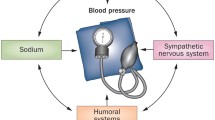Abstract
Maintaining blood pressure control and reducing proteinuria in hypertensive patients with chronic kidney disease is crucial to prevent the progression of kidney disease and the development or worsening of cardiovascular disease. Pharmacological treatment recommendations vary depending on the specific aetiology of disease, as well as patient characteristics. The majority of patients will require multi-drug therapy in order to achieve blood pressure goals.
Similar content being viewed by others
References
Talreja H, Ruzicka M, McCormick BB. Pharmacologic treatment of hypertension in patients with chronic kidney disease. Am J Cardiovasc Drugs. 2013;13(3):177–88.
Muntner P, Anderson A, Charleston J, et al. Hypertension awareness, treatment, and control in adults with CKD: results from the Chronic Renal Insufficiency Cohort (CRIC) Study. Am J Kidney Dis. 2010;55(3):441–51.
Strazzullo P, Galletti F, Barba G. Altered renal handling of sodium in human hypertension: short review of the evidence. Hypertension. 2003;41(5):1000–5.
Weidmann P, Maxwell MH, Lupu AN, et al. Plasma renin activity and blood pressure in terminal renal failure. N Engl J Med. 1971;285(14):757–62.
Converse RL Jr, Jacobsen TN, Toto RD, et al. Sympathetic overactivity in patients with chronic renal failure. N Engl J Med. 1992;327(27):1912–8.
Vasavada N, Agarwal R. Role of excess volume in the pathophysiology of hypertension in chronic kidney disease. Kidney Int. 2003;64(5):1772–9.
Boudville N, Ward S, Benaroia M, et al. Increased sodium intake correlates with greater use of antihypertensive agents by subjects with chronic kidney disease. Am J Hypertens. 2005;18(10):1300–5.
Rabi DM, Daskalopoulou SS, Padwal RS, et al. The 2011 Canadian Hypertension Education Program recommendations for the management of hypertension: blood pressure measurement, diagnosis, assessment of risk, and therapy. Can J Cardiol. 2011;27(4):415–33 e1-2.
Kidney Disease Outcomes Quality Initiative (K/DOQI). KDOQI clinical practice guidelines on hypertension and antihypertensive agents in chronic kidney disease. Am J Kidney Dis. 2004;43(5 Suppl 1):1–290.
Brater DC. Diuretic therapy. N Engl J Med. 1998;339(6):387–95.
Acchiardo SR, Skoutakis VA. Clinical efficacy, safety, and pharmacokinetics of indapamide in renal impairment. Am Heart J. 1983;106(1 Pt 2):237–44.
Dargie HJ, Allison ME, Kennedy AC, et al. Efficacy of metolazone in patients with renal edema. Clin Nephrol. 1974;2(4):157–60.
The GISEN Group (Gruppo Italiano di Studi Epidemiologici in Nefrologia). Randomised placebo-controlled trial of effect of ramipril on decline in glomerular filtration rate and risk of terminal renal failure in proteinuric, non-diabetic nephropathy. Lancet. 1997;349(9069):1857–63.
The ALLHAT Officers and Coordinators for the ALLHAT Collaborative Research Group. Major outcomes in high-risk hypertensive patients randomized to angiotensin-converting enzyme inhibitor or calcium channel blocker vs diuretic: the Antihypertensive and Lipid-Lowering Treatment to Prevent Heart Attack Trial (ALLHAT). JAMA. 2002;288(23):2981–97.
Brenner BM, Cooper ME, de Zeeuw D, et al. Effects of losartan on renal and cardiovascular outcomes in patients with type 2 diabetes and nephropathy. N Engl J Med. 2001;345(12):861–9.
Lewis EJ, Hunsicker LG, Clarke WR, et al. Renoprotective effect of the angiotensin-receptor antagonist irbesartan in patients with nephropathy due to type 2 diabetes. N Engl J Med. 2001;345(12):851–60.
Hemodialysis Adequacy Work Group. Clinical practice guidelines for hemodialysis adequacy, update 2006. Am J Kidney Dis. 2006;48(Suppl 1):S2–90.
Cice G, Ferrara L, D’Andrea A, et al. Carvedilol increases two-year survival in dialysis patients with dilated cardiomyopathy: a prospective, placebo-controlled trial. J Am Coll Cardiol. 2003;41(9):1438–44.
Jamerson K, Weber MA, Bakris GL, et al. Benazepril plus amlodipine or hydrochlorothiazide for hypertension in high-risk patients. N Engl J Med. 2008;359(23):2417–28.
Chapman N, Dobson J, Wilson S, et al. Effect of spironolactone on blood pressure in subjects with resistant hypertension. Hypertension. 2007;49(4):839–45.
Bianchi S, Bigazzi R, Campese VM. Long-term effects of spironolactone on proteinuria and kidney function in patients with chronic kidney disease. Kidney Int. 2006;70(12):2116–23.
ONTARGET Investigators, Yusuf S, Teo KK, et al. Telmisartan, ramipril, or both in patients at high risk for vascular events. N Engl J Med. 2008;358(15):1547–59.
Parving HH, Brenner BM, McMurray JJ, et al. Cardiorenal end points in a trial of aliskiren for type 2 diabetes. N Engl J Med. 2012;367(23):2204–13.
Zannad F, Matzinger A, Larche J. Trough/peak ratios of once daily angiotensin converting enzyme inhibitors and calcium antagonists. Am J Hypertens. 1996;9(7):633–43.
Hermida RC, Ayala DE, Mojon A, et al. Bedtime dosing of antihypertensive medications reduces cardiovascular risk in CKD. J Am Soc Nephrol. 2011;22(12):2313–21.
Disclosure
This article was adapted from the American Journal of Cardiovascular Drugs 2013;13(3):177–88 [1]. The preparation of these articles was not supported by any external funding.
Author information
Authors and Affiliations
Consortia
Rights and permissions
About this article
Cite this article
Adis Medical Writers. Consider specific co-morbidities and disease aetiology when treating hypertension in patients with chronic kidney disease. Drugs Ther Perspect 30, 60–64 (2014). https://doi.org/10.1007/s40267-013-0091-3
Published:
Issue Date:
DOI: https://doi.org/10.1007/s40267-013-0091-3




